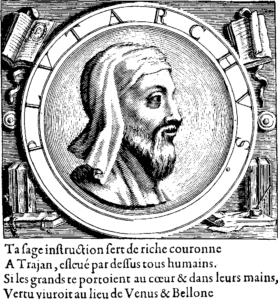100 C.E. Plutarch (46 C.E. ― 120 C.E.)
 Destruction of the Second Temple, Sabbath, Tisha B’Av
Destruction of the Second Temple, Sabbath, Tisha B’Av
De Superstitione, 8, p. 169C
(p549) But the Jews, because it was the Sabbath day, sat in their places immovable, while the enemy were planting ladders against the walls and capturing the defences, and they did not get up, but remained there, fast bound in the toils of superstition as in one great net.
Yom Kippur, Sukkot, and Shemini Atzeret
Quaestiones Convivales, IV, 4:4 – 6:2, pp. 669 C – 672 B
(6:2) At this, all did urge him (e.g. Moeragenes) and beg him to go on. “First,” he said, “the time and character of the greatest, most sacred holiday of the Jews clearly befit Dionysus. When they celebrate their so-called Fast, at the height of the vintage, they set out tables of all sorts of fruit under tents and huts plaited for the most part of vines and ivy. They call the first of the days of the Feast Tabernacles. A few days later they celebrate another festival, this time identified with Bacchus not through obscure hints but plainly called by his name, a festival that is a sort of ‘Procession of Branches’ or ‘Thyrsus Procession,’ in which they enter the temple each carrying a thyrsus.
Passover 168 B.C.E.
Regum et Imperatorum Apophthemata, p. 184E-F
(p563) The Jews, when he (e.g. Antiochus IV) was besieging Jerusalem 168 B.C.E., asked for an armistice of seven days for their most important festival, and he not only granted this, but he also made ready bulls with gilded horns, and a great quantity of incense and spices, and brought all these in solemn procession as far as the gates. Then having transferred the offerings to the hands of their priests, he returned to his camp. The Jews were amazed, and immediately after the festival placed themselves in his hands.
Source: Menahem, Stern. Greek and Latin Authors on Jews and Judaism. Volume I (p. 549, 563-564, 568-569, 573-575)



